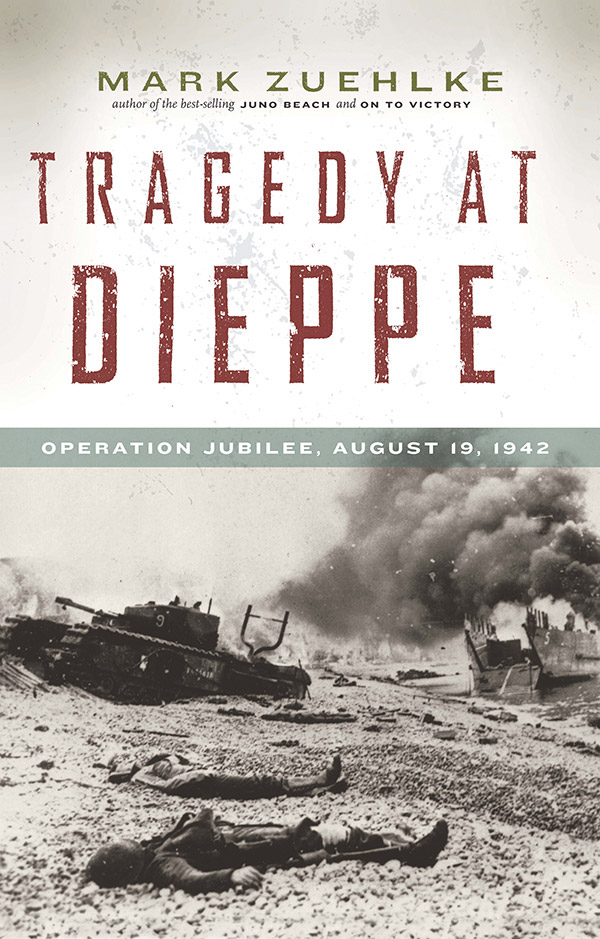Tragedy at Dieppe

Operation Jubilee, August 19, 1942
by Mark Zuehlke
Douglas & McIntyre
537 pages, $27.95
A double review with
One Day in August: The Untold Story Behind Canada’s Tragedy at Dieppe
by David O’Keefe
Alfred A. Knopf Canada
493 pages, $35
The disastrous Canadian raid on the French seaside village of Dieppe on August 19, 1942, still summons passion and anger among Canadians today. Flanked on either side by sheer cliffs, the town was well armed and presented a natural defensive position. The attacking soldiers of the 2nd Canadian Infantry Division were shattered and maimed at the water’s edge. Most of those lucky enough to survive spent the rest of the war in a German prisoner of war camp.
How could this raid have been conceived, and how could it ever have been expected to succeed? Two new books with significantly different approaches to history revisit Dieppe once more and try to provide Canadians with answers to these questions.
Tragedy at Dieppe is the tenth book in Mark Zuehlke’s series that follows the Canadian army through the Second World War. Zuehlke’s self-described “you are there” style succeeds in putting readers into the horror of the Dieppe landing. The graphic accounts of Canadian soldiers slaughtered helplessly on the beaches at Dieppe and the surrounding towns are troubling and horrifying.
Zuehlke provides an exceptional look at the battle. For readers trying to orient themselves to the events of the operation, this is an excellent guide, pulling together official personal and battalion reports.
However, while the after-action reports provide strong first-hand accounts, they nonetheless view the battle through an official military filter. There are times when the book reads as an extended official report, with entire paragraphs pulled directly from such material.
More importantly, Dieppe is a different type of battle than those Zuehlke has written about in the past. Unlike lesser-known and largely ignored campaigns such as Sicily, Ortona, and the Scheldt, Dieppe has been debated and documented numerous times. The battle needs more than a silent guide following the experiences of the soldiers. It needs a narrator who can guide readers through the historical minefields around the event that have been left by past studies. In that respect, Tragedy at Dieppe is largely lacking.
One Day in August, by David O’Keefe, takes a completely different approach to the Dieppe landing. With significant new evidence in hand, O’Keefe seeks to reframe the entire raid within the context of the secret naval intelligence war being fought against Nazi Germany.
On February 1, 1942, German U-boats operating in the Atlantic Ocean switched from using a three-rotor Enigma code machine to a new four-rotor machine. Britain’s Naval Intelligence Division, which had broken the three-rotor code and was regularly reading German coded messages, was suddenly left entirely in the dark as to the positions and intentions of enemy submarines. By the summer of 1942, the Battle of the Atlantic had reached a state of crisis and was threatening to cut off Britain from the resources needed to carry on with the war.
O’Keefe spends nearly two hundred pages documenting the secret war against Germany and the growth of the Naval Intelligence Division. What ties this to Dieppe and sparked O’Keefe’s research was the development of a unique naval intelligence commando unit tasked with retrieving vital code-breaking material. As O’Keefe’s research reveals, the origins of this unit were at Dieppe, on an almost suicidal mission to gather intelligence they hoped would crack the four-rotor Enigma machine.
O’Keefe has uncovered new documents and first-hand accounts that provide evidence for the existence of such a mission. But he takes it one step further and argues that these secret commandos were not simply along for the ride at Dieppe. Instead, he claims, the entire Dieppe raid was cover for their important task.
It’s easy to dismiss O’Keefe’s argument as too incredible (Zuehlke does so quickly in his brief conclusion). But O’Keefe would argue that just about everything associated with combined operations defied conventional military logic, from Operation Ruthless, a planned but never executed James Bond-style mission, to the successful raid on the French port of St. Nazaire only months before Dieppe.
Clearly this commando operation was an important part of the Dieppe raid. But, while the circumstantial evidence is robust, there is no single clear document that directly lays out the Dieppe raid as cover for a secret “pinch by design” operation to steal German code books and Enigma material.
Taken together, these books present an exceptional opportunity to re-examine this important moment in Canadian history. Zuehlke provides a summary that clearly outlines the Canadian experience, while O’Keefe has uncovered an entire mission within the raid whose story until now had gone largely untold. All this suggests that a healthy debate on the Dieppe raid is only just getting started and that the final story has yet to be written.
Themes associated with this article
Advertisement








